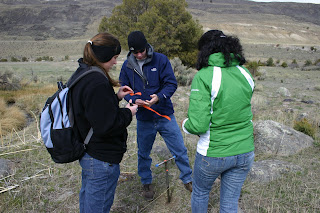Today began with light snow and 20F temperatures.
I had a meeting with Mary Hektner. Mary works for at the Yellowstone Center for Resources-National Park Service and is the coordinator of the restoration project in the Gardiner Basin. We scheduled our coffee break presentation to YCR staff for May 7 at 10:30 where we will present the data we have collected and our plans for follow up experiments after we return to campus. While I was in the meeting everyone else went to the Albright Visitors center at Mammoth Hot Springs and watched a movie about the park (still 2 more to watch, they let you choose). We then returned to the lodge to finish our soil incubation tubes. This method is based on a paper published in 1940 in which soil bacteria and fungi (collectively called soil microbes) are collected by burying a glass tube that has thousands of small holes and is filled with nutrient agar. After a period of time the tube is removed and the agar is removed for the determination of diversity and abundance. We modified this method by cutting out channels in plastic centrifuge tubes and gluing on a 37 micron nylon mesh through which fungal hyphae and bacteria could pass but most, if not all, roots cannot. We filled them with agar and an extract of soil collected from one of the four species of interest (A. desertorum, P. secunda, E. triticeum, or, A. cristatum) . This will allow us to investigate changes in soil organic matter quality and any possible anti-microbial properties of the soils. In the video below Becca, Camden and Brittany are pouring agar into the soil incubation tubes. While we don't have a sterile lab to do this work in we do have an alcohol lamp, low humdity and low temperature on our side.
Becca, Camden and Maya installing the soil incubation tubes.
David, Brittany and Mackenzie installing tubes.
The tubes installed (we put in 36 total)
Not a bad view for a lab.
Tomorrow we will be plating out soil bacteria and fungi for most probable number counts (a measure of abundance) and collecting soils from a reminant native grassland in the Gardiner Basin and surface soils in the GB to determine the seed banks of the 4 species of interest. We may take a dusk trip out to look for wildlife. Still need to see a grizz from a safe distance. Today we saw a coyote try to take down a yearling Elk. It wasn't going to happen, but fun to watch nonetheless.





No comments:
Post a Comment